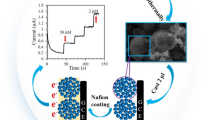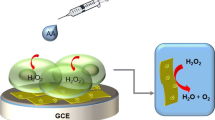Abstract
Two kinds of carbon-based nanozymes were constructed from the same precursor of zeolitic imidazolate framework-8 (ZIF-8) for O2•− determination. Hollow carbon cubic nanomaterial (labelled as HCC) was obtained by chemically etching ZIF-8 with tannic acid and a subsequent calcination. A porous carbon cubic nanomaterial (labelled as PCC) was prepared by directly pyrolysis. Then HCC and PCC were immobilized on the surface of screen printed carbon electrodes (SPCE), fabricating HCC and PCC modified electrodes (denoted as HCC/SPCE and PCC/SPCE). HCC/SPCE, best operated at −0.5 V (vs. Ag/AgCl), has a sensitivity of 6.55 × 102 nA μM−1 cm−2 with a detection limit of 207 nM (at S/N = 3) for O2•− sensing. And PCC/SPCE, best operated at −0.4 V (vs. Ag/AgCl), exhibited a superior performance for O2•− detection with a sensitivity of 1.14 × 103 nA μM−1 cm−2 and a low detection limit of 140 nM (at S/N = 3). The two sensors possess excellent reproducibility and stability. They were used to sense O2•− released from HeLa cells.

Illustration of the synthesis of the hollow carbon cubic nanomaterial (HCC) and of the porous carbon cubic nanomaterial (PCC), and the scheme for detection of superoxide anions in HeLa cell.





Similar content being viewed by others
References
Valko M, Rhodes CJ, Moncol J, Izakovic M, Mazur M (2006) Free radicals, metals and antioxidants in oxidative stress-induced cancer. Chem Biol Interact 160(1):1–40
Valko M, Leibfritz D, Moncol J, Cronin MT, Mazur M, Telser J (2007) Free radicals and antioxidants in normal physiological functions and human disease. Int J Biochem Cell B 39(1):44–84
Pagliari F, Mandoli C, Forte G, Magnani E, Pagliari S, Nardone G, Licoccia S, Minieri M, Di Nardo P, Traversa E (2012) Cerium oxide nanoparticles protect cardiac progenitor cells from oxidative stress. ACS Nano 6(5):3767–3775
Ignatov S, Shishniashvili D, Ge B, Scheller FW, Lisdat F (2002) Amperometric biosensor based on a functionalized gold electrode for the detection of antioxidants. Biosens Bioelectron 17(3):191–199
Zhu X, Niu X, Zhao H, Tang J, Lan M (2015) Immobilization of superoxide dismutase on Pt-Pd/MWCNTs hybrid modified electrode surface for superoxide anion detection. Biosens Bioelectron 67:79–85
Zhu X, Liu T, Zhao H, Shi L, Li X, Lan M (2016) Ultrasensitive detection of superoxide anion released from living cells using a porous Pt-Pd decorated enzymatic sensor. Biosens Bioelectron 79:449–456
Luo Y, Tian Y, Rui Q (2009) Electrochemical assay of superoxide based on biomimetic enzyme at highly conductive TiO2 nanoneedles: from principle to applications in living cells. Chem Commun 21:3014–3016
Wei H, Shang T, Wu T, Liu G, Ding L, Liu X (2018) Construction of an ultrasensitive non-enzymatic sensor to investigate the dynamic process of superoxide anion release from living cells. Biosens Bioelectron 100:8–15
Liu Y, Liu X, Liu Y, Liu G, Ding L, Lu X (2017) Construction of a highly sensitive non-enzymatic sensor for superoxide anion radical detection from living cells. Biosens Bioelectron 90:39–45
Wu T, Li L, Song G, Ran M, Lu X, Liu X (2019) An ultrasensitive electrochemical sensor based on cotton carbon fiber composites for the determination of superoxide anion release from cells. Microchim Acta 186(3):198
Cai X, Shi L, Sun W, Zhao H, Li H, He H, Lan M (2018) A facile way to fabricate manganese phosphate self-assembled carbon networks as efficient electrochemical catalysts for real-time monitoring of superoxide anions released from HepG2 cells. Biosens Bioelectron 102:171–178
Zheng J, Wang B, Jin Y, Weng B, Chen J (2019) Nanostructured MXene-based biomimetic enzymes for amperometric detection of superoxide anions from HepG2 cells. Microchim Acta 186(2):95
Wang Y, Wang M-Q, Lei L-L, Chen Z-Y, Liu Y-S, Bao S-J (2018) FePO4 embedded in nanofibers consisting of amorphous carbon and reduced graphene oxide as an enzyme mimetic for monitoring superoxide anions released by living cells. Microchim Acta 185(2):140
Niu X, Zhao H, Chen C, Lan M (2013) Enhancing the Electrocatalytic activity of Pt-Pd catalysts by introducing porous architectures. ChemCatChem 5(6):1416–1425
Shen X, Wang Q, Liu Y, Xue W, Ma L, Feng S, Wan M, Wang F, Mao C (2016) Manganese phosphate self-assembled nanoparticle surface and its application for superoxide anion detection. Sci Rep 6:28989
Wei H, Wang EK (2013) Nanomaterials with enzyme-like characteristics (nanozymes): next-generation artificial enzymes. Chem Soc Rev 42(14):6060–6093
Liu L, Zhao H, Shi L, Lan M, Zhang H, Yu C (2017) Enzyme-and metal-free electrochemical sensor for highly sensitive superoxide anion detection based on nitrogen doped hollow mesoporous carbon spheres. Electrochim Acta 227:69–76
Cai X, Chen HL, Wang ZX, Sun WQ, Shi LB, Zhao HL, Lan MB (2019) 3D graphene-based foam induced by phytic acid: an effective enzyme-mimic catalyst for electrochemical detection of cell-released superoxide anion. Biosens Bioelectron 123:101–107
Horcajada P, Chalati T, Serre C, Gillet B, Sebrie C, Baati T, Eubank JF, Heurtaux D, Clayette P, Kreuz C, Chang J-S, Hwang YK, Marsaud V, Bories P-N, Cynober L, Gil S, Férey G, Couvreur P, Gref R (2009) Porous metal-organic-framework nanoscale carriers as a potential platform for drug delivery and imaging. Nat Mater 9:172
Banerjee R, Furukawa H, Britt D, Knobler C, O’Keeffe M, Yaghi OM (2009) Control of pore size and functionality in Isoreticular Zeolitic Imidazolate frameworks and their carbon dioxide selective capture properties. J Am Chem Soc 131(11):3875–3877
Gascon J, Corma A, Kapteijn F, Llabrés i, Xamena FX (2014) Metal organic framework catalysis: quo vadis? ACS Catal 4(2):361–378
Ji D, Zhou H, Zhang J, Dan YY, Yang HX, Yuan AH (2016) Facile synthesis of a metal-organic framework-derived Mn2O3 nanowire coated three-dimensional graphene network for high-performance free-standing supercapacitor electrodes. J Mater Chem A 4(21):8283–8290
Zheng F, Yang Y, Chen Q (2014) High lithium anodic performance of highly nitrogen-doped porous carbon prepared from a metal-organic framework. Nat Commun 5:5261
Chen L, Wang Z, He C, Zhao N, Shi C, Liu E, Li J (2013) Porous graphitic carbon Nanosheets as a high-rate anode material for Lithium-ion batteries. ACS Appl Mater Interfaces 5(19):9537–9545
Wang CH, Liu C, Li JS, Sun XY, Shen JY, Han WQ, Wang LJ (2017) Electrospun metal-organic framework derived hierarchical carbon nanofibers with high performance for supercapacitors. Chem Commun 53(10):1751–1754
Zhang W, Jiang XF, Zhao YY, Carne-Sanchez A, Malgras V, Kim J, Kim JH, Wang SB, Liu J, Jiang JS, Yamauchi Y, Hu M (2017) Hollow carbon nanobubbles: monocrystalline MOF nanobubbles and their pyrolysis. Chem Sci 8(5):3538–3546
Hyland K, Auclair C (1981) The formation of superoxide radical anions by a reaction between O2, OH− and dimethyl sulfoxide. Biochem Biophys Res Commun 102(1):531–537
Thandavan K, Gandhi S, Sethuraman S, Rayappan JBB, Krishnan UM (2013) A novel nano-interfaced superoxide biosensor. Sensors Actuators B Chem 176:884–892
Hu M, Ju Y, Liang K, Suma T, Cui JW, Caruso F (2016) Void engineering in metal-organic frameworks via synergistic etching and surface functionalization. Adv Funct Mater 26(32):5827–5834
Avci C, Arinez-Soriano J, Carne-Sanchez A, Guillerm V, Carbonell C, Imaz I, Maspoch D (2015) Post-synthetic anisotropic wet-chemical etching of colloidal sodalite ZIF crystals. Angew Chem Int Ed 54(48):14417–14421
Shen J, Li Y, Wang C, Luo R, Li J, Sun X, Shen J, Han W, Wang L (2018) Hollow ZIFs-derived nanoporous carbon for efficient capacitive deionization. Electrochim Acta 273:34–42
Zhang LJ, Su ZX, Jiang FL, Yang LL, Qian JJ, Zhou YF, Li WM, Hong MC (2014) Highly graphitized nitrogen-doped porous carbon nanopolyhedra derived from ZIF-8 nanocrystals as efficient electrocatalysts for oxygen reduction reactions. Nanoscale 6(12):6590–6602
Dashtestani F, Ghourchian H, Eskandari K, Rafiee-Pour H-A (2015) A superoxide dismutase mimic nanocomposite for amperometric sensing of superoxide anions. Microchim Acta 182(5–6):1045–1053
Liu T, Niu X, Shi L, Zhu X, Zhao H, Lana M (2015) Electrocatalytic analysis of superoxide anion radical using nitrogen-doped graphene supported Prussian blue as a biomimetic superoxide dismutase. Electrochim Acta 176:1280–1287
Santhosh P, Manesh KM, Lee S-H, Uthayakumar S, Gopalan AI, Lee K-P (2011) Sensitive electrochemical detection of superoxide anion using gold nanoparticles distributed poly (methyl methacrylate)-polyaniline core-shell electrospun composite electrode. Analyst 136(8):1557–1561
Han M, Guo P, Wang X, Tu W, Bao J, Dai Z (2013) Mesoporous SiO2-(l)-lysine hybrid nanodisks: direct electron transfer of superoxide dismutase, sensitive detection of superoxide anions and its application in living cell monitoring. RSC Adv 3(43):20456–20463
Acknowledgements
This research was financially supported by the Science and Technology Commission of Shanghai Municipality (STCSM, No. 16520710800) and the Fundamental Research Funds for the Central Universities (No. 50321101917022).
Author information
Authors and Affiliations
Corresponding authors
Ethics declarations
The author(s) declare that they have no competing interests.
Additional information
Publisher’s note
Springer Nature remains neutral with regard to jurisdictional claims in published maps and institutional affiliations.
Highlights
• A facile method to fabricate two kinds of carbon-based nanozymes for superoxide sensing.
• Two novel non-enzymatic O2•− sensors were established.
• The recommended two sensors can successfully capture the electrochemical signals of O2•− released from Hela cells.
Electronic supplementary material
ESM 1
(DOCX 1223 kb)
Rights and permissions
About this article
Cite this article
Li, Y., Zhang, H., Cai, X. et al. Electrochemical detection of superoxide anions in HeLa cells by using two enzyme-free sensors prepared from ZIF-8-derived carbon nanomaterials. Microchim Acta 186, 370 (2019). https://doi.org/10.1007/s00604-019-3473-y
Received:
Accepted:
Published:
DOI: https://doi.org/10.1007/s00604-019-3473-y




